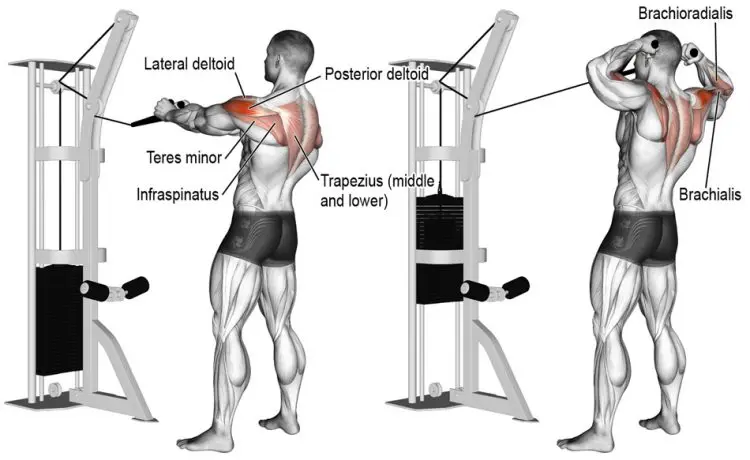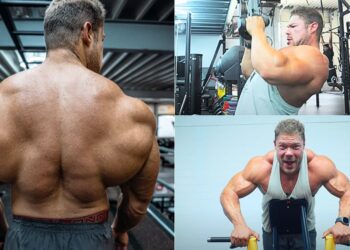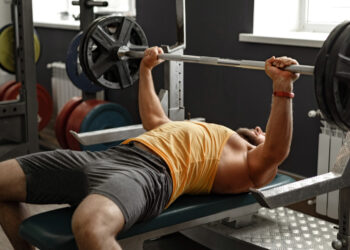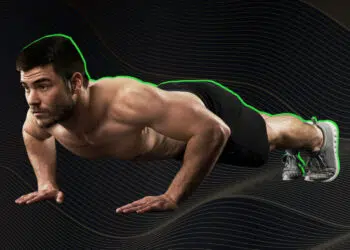When it comes to deltoid training, most people focus on their deltoids by doing lots of overhead presses and lateral raises. However, those exercises only work two of the three available deltoid heads – anterior and medial.
So, what about the rear delts?
The rear deltoid is often ignored or forgotten and, as such, woefully underdeveloped. That’s a shame because good rear delts can add a lot to your upper back shape and size and are critical for shoulder health and stability.
It’s time to stop treating your rear deltoids as an afterthought!
Give them the attention they deserve by including dumbbell rear delt rows in your shoulder or back workouts.
Dumbbell Rear Delt Row – Muscles Worked
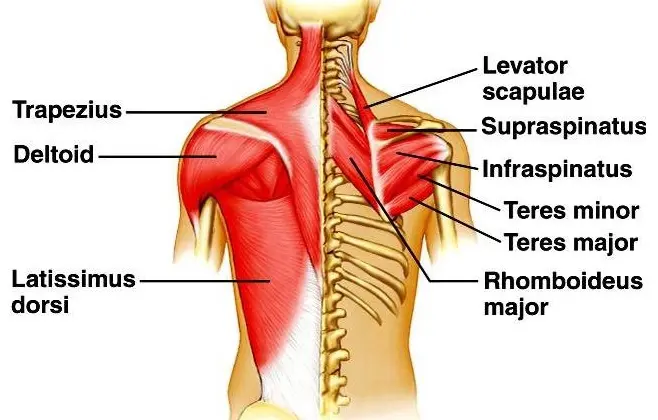
Dumbbell rear delt rows are a compound exercise. That means they involve several joints and muscles working together. The main muscles involved in this exercise are:
Level Up Your Fitness: Join our 💪 strong community in Fitness Volt Newsletter. Get daily inspiration, expert-backed workouts, nutrition tips, the latest in strength sports, and the support you need to reach your goals. Subscribe for free!
Posterior deltoids – the deltoids are your primary shoulder muscles. There are three deltoid sections or heads: anterior (front), medial (side), and posterior (rear). As their name suggests, dumbbell rear delt rows hit the posterior deltoids. The functions of the posterior deltoids are horizontal extension, extension, and external rotation of the shoulder joint.
Trapezius and rhomboids – the trapezius and rhomboids are your upper back muscles. They’re located across and between your scapulae or shoulder blades. Dumbbell rear delt rows target the middle fibers of the trapezius and the rhomboids. These muscles work together to draw your shoulder blades back and together, which is a movement called retraction.
Biceps brachii – located on the front of your upper arms, the biceps brachii, or biceps for short, flexes your elbows and supinates your forearms. However, because rear delt rows are typically done using light weights, the biceps don’t really get much of a workout during this exercise.
How to Do Dumbbell Rear Delt Rows
Get more from dumbbell rear delt rows while keeping your risk of injury to a minimum by following these guidelines:
- Sit on the end of an exercise bench with a dumbbell in each hand. Hinge forward from the hips and lower your chest toward your legs. Let your arms hang down from your shoulders. Rotate your wrists so that your hands are in the pronated or palms down position.
- Leading with your elbows, pull the weights up and out, so your upper arms are perpendicular to your upper body. Keep your wrists straight and pull your shoulders down and back.
- Extend your arms and repeat.
This exercise can also be done standing if preferred.
Dumbbell Rear Delt Rows Benefits
Not sure if dumbbell rear delt rows deserve a place in your workouts? Consider these benefits and then decide!
Accessible – all you need for dumbbell rear delt rows is a pair of light dumbbells and somewhere to sit. Use a chair if you don’t have a bench. You can also do this exercise from standing. As such, it’s a very accessible exercise that most lifters should be able to do.
An excellent postural exercise – dumbbell rear delt rows work the muscles responsible for maintaining good posture and preventing slouching and rounded shoulders. As such, it’s the ideal exercise for anyone who spends long periods sitting at a desk.
Easy to do – the dumbbell rear delt row is easy to learn and master. It’s ideal for beginners but is also suitable for more advanced exercisers. Using light weights means it not as intimidating as some other rowing exercises, such as single-arm bent-over rows and Kroc rows.
Dumbbell Rear Delt Rows Drawbacks
While dumbbell rear delt rows are a mostly beneficial exercise, there are also a couple drawbacks to consider:
You must keep your elbows away from your sides – most rowing exercises are done with the arms close to the sides. This is the best way to recruit the lats. However, dumbbell rear delt rows must be done with the arms up and perpendicular to the body, or they won’t be as effective. This takes a little practice and discipline. However, using too much weight may mean you end up doing lat rows instead of rear delt rows.
Rounded lower back – done seated or standing, there may be a tendency to round your lower back during this exercise, especially if you have tight hamstrings. A rounded lower back is a weak lower back and prone to pain and injury. As such, you must do your best not to round your back during dumbbell rear delt rows.
Using heavy weights – dumbbell rear delt rows are not meant to be done with ultra-heavy weights. Using big dumbbells will undoubtedly result in more lat and less rear delt engagement. If you like to lift heavy, and struggle to keep your ego in check, you may find that this exercise turns into just another rowing exercise and your rear delts won’t get much benefit.
10 Dumbbell Rear Delt Row Variations and Alternatives
Dumbbell rear delt rows are a highly effective posterior shoulder and upper back exercise, but that doesn’t mean you need to do them all the time. There are plenty of variations and alternatives you can use to keep your workouts productive and interesting:
1. Wide grip seated cable row
The wide grip seated cable row works just like dumbbell rear delt rows but is much easier because it’s done in a more comfortable seated position. This takes some stress off your lower back and leaves you free to focus on working your rear deltoids and upper back. You can do this exercise on any standard seated cable row machine using a long lat pulldown bar.
How to do it:
- Attach a long, straight bar to a low cable row machine. Sit on the machine and hold the bar with a wide, overhand grip. With your knees slightly bent, sit up straight, pull your shoulders down and back, and brace your core.
- Without using your legs or leaning back, bend your arms and pull the center of the bar into your chest at or above sternum height. Keep your elbows up, pull your shoulders together, and pause for 1-2 seconds.
- Extend your arms and repeat.
Learn more about wide grip seated rows here.
2. Wide grip chest supported row
If you are one of those people who can’t help but use their legs or lower backs during seated or bent-over rows, this is the exercise for you. Lying face down on a bench means your lower back is removed from the movement entirely, so you’re left free to focus on your rear delts and upper back. This is also a good exercise for anyone with lower back pain.
How to do it:
- Lie face down on an inclined bench set to around 30-degrees. Hold a dumbbell in each hand and let your arms hang straight down from your shoulders. Raise the bench on blocks if you are unable to straighten your arms.
- Rotate your wrists, so the backs of your hands are facing the front, i.e., a pronated grip. Pull your shoulders down and back.
- Leading with your elbows, pull the weights up and out so your upper arms are perpendicular to your body. Pull your shoulders down and back.
- Extend your arms and repeat.
3. Wide grip bent-over row
Bent-over rows are something of a classical bodybuilding exercise. Some trainers view them as being too old-school. However, despite being a less fashionable exercise, bent-over rows are still a great back builder.
Done with a wide, overhand grip, the bent-over row also delivers an excellent posterior deltoid and upper back workout. That said, you will need to work hard to maintain the proper position and avoid rounding your lumbar spine.
How to do it:
Level Up Your Fitness: Join our 💪 strong community in Fitness Volt Newsletter. Get daily inspiration, expert-backed workouts, nutrition tips, the latest in strength sports, and the support you need to reach your goals. Subscribe for free!
- Grip and hold a barbell with an overhand, wider than shoulder-width grip. Pull your shoulders down and back, brace your core and bend your knees slightly.
- Hinge forward from the hips and lean over until your upper body is almost parallel with the floor. Let your arms hang straight down from your shoulders.
- Without using your legs or back, bend your arms and row the bar up and into your chest. Pull your shoulders back and keep your elbows level with your shoulders.
- Extend your arms and repeat.
Discover more about bent-over rows here.
4. Reverse cable crossovers
Reverse cable crossovers are an excellent posterior deltoid exercise. Unlike most free-weight rear delt movements, the target muscles are under almost constant tension, and it’s much harder to use momentum to lift the weights. This all adds up to a very effective and efficient way to train your rear delts and upper back.
How to do it:
- Stand in the middle of a cable crossover machine and attach a D-handle to the high pulleys. Alternatively, you can just hold the ends of the cables.
- Hold the left handle/cable in your right hand and the right handle/cable in your left hand. Raise your arms out in front of you.
- With a slight bend in your elbows, open your arms and extend them back to form a T-shape.
- Bring your hands back together and repeat.
- You can also do this exercise supine and lying on a flat bench.
For variety, do this exercise using one arm/cable at a time.
5. Face pulls
Face pulls target your entire upper back, i.e., the mid-traps, rhomboids, AND posterior deltoids. They’re an excellent postural exercise and one that could add some thickness to your upper back muscles. Face pulls are also good for your shoulder health and could help ward off shoulder joint pain.
However, to get the best possible results, make sure you keep your arms up and really drive your elbows back. If you don’t, you could end up using your lats more than your rear delts and upper back.
- Attach a rope handle to a cable pulley set to about chest height.
- Stand with your feet hip-width apart and grab both sides of the handle using a neutral grip. Place one foot in front of the other for balance if necessary.
- Keeping your elbows level with your shoulders, bend your arms and pull the rope toward your face, contracting your rear deltoids as you pull the ends of the handle apart.
- Straighten your arms and repeat for the desired number of reps.
Learn more about face pulls here.
6. Dumbbell rear delt raises
Where dumbbell rear delt rows are a compound exercise, dumbbell rear delt raises are more of an isolation exercise as they don’t involve your biceps. This doesn’t make them any better or worse than the rear delt row, only different. As such, they could be a valuable addition to your training library, and you can use them anytime you need an alternative to rear delt rows.
How to do it:
- Sit on the end of an exercise bench with a dumbbell in each hand. Hinge forward from the hips and lower your chest toward your legs. Let your arms hang down from your shoulders so that your hands are in the neutral or palms-in position.
- Keeping your elbows slightly bent but rigid, open your arms and raise them to form a T-shape with your body.
- Lower your arms and repeat.
This exercise can also be done standing if preferred, but you’ll probably find it easier if you rest your head on the back of a bench to support your spine.
7. Band pull-aparts
Rear delt exercises don’t come much more convenient than the band pull-apart. You can do this exercise almost anywhere and anytime. As well as being an excellent posterior shoulder exercise, the band pull-apart is a valuable postural exercise and a powerful antidote to all the sitting that most people do.
A few sets of band pull-aparts will also help wake up your shoulder stabilizers to make any upper body workout more productive and safer.
How to do it:
- Hold a resistance band with an overhand, shoulder-width grip. Raise your arms up in front of you, so they’re parallel to the floor. Pull your shoulders down and back, and brace your abs.
- Without flexing your elbows, open your arms and stretch the band out across your chest.
- Return to the starting position and repeat.
Read more about band pull-aparts here.
8. Wide grip T-bar rows
T-bar rows are a very popular lat exercise. They’re typically done using a narrow, neutral grip. However, most T-bar row machines also have a wide grip, and that’s perfect for working your rear deltoids and upper back. Because of the angle of your torso during T-bar rows, you may find this exercise more lower-back-friendly than other types of bent-over row.
How to do it:
- Step onto the T-bar row platform and stand with one foot on either side of the bar. Your feet should be between shoulder to hip-width apart.
- With your feet flat, bend your knees slightly and hinge forward from your hips. Keep your back slightly arched.
- Grasp the wide handles with a wide, overhand grip. With your arms straight, lift the weight up until your torso is between 45 degrees and parallel to the floor.
- Bend your arms and pull the handle into your chest. Lead with your elbows and keep your wrists straight. Do not allow your lower back to round.
- Fully extend your arms and repeat.
Learn all about T-bar rows in our in-depth guide.
9. Reverse pec deck fly
This exercise is performed on the pec deck machine, but the movement is reversed. Reverse pec deck flyes require less stabilization than other rear delt exercises as the action is guided by the machine. As such, you don’t have to worry about balancing the weight or coordinating your movements. Because of this, most exercisers will be able to use heavier weights which is very beneficial for muscle hypertrophy.
How to do it:
- Sit on the pec deck machine with your chest against the pad. Reach out and grab the handles with a neutral or pronated grip as preferred. Extend but do not fully straighten your arms. Your hands should be level with or just below your shoulders.
- Open your arms and draw the handles out and back until your arms form a T-shape with your body.
- Return to the starting position, stopping just short of letting the weights touch down, and repeat.
10. Wide grip inverted row
Like most rowing exercises, most people associate inverted rows with the latissimus dorsi. And while this can be a good lat exercise, you can also modify it to make it much more rear delt and upper back-centric. Simply move your hands out wider and pull your chest up to the bar.
How to do it:
- Set the bar on a Smith machine to about hip height. Alternatively, you can use a barbell in a power rack.
- Sit on the floor below the bar and hold it with an overhand, slightly wider than shoulder-width grip. Brace your core and pull your shoulders down and back.
- Lift your body so your knees and hips are straight and your arms are extended.
- Bend your elbows and pull your chest up to the bar. Keep your wrists and entire body straight.
- Straighten your arms and repeat.
- Make this exercise easier by raising the bar so your body is at a steeper angle, or more challenging by raising your feet or resting a weight plate on your hips.
Dumbbell Rear Delt Rows – Wrapping Up
There are three deltoid heads – anterior, medial, and posterior – and they all need to be trained pretty equally to build an aesthetically pleasing and structurally solid upper body.
There are plenty of rear deltoid exercises to choose from, but the dumbbell rear delt row is among the best. You can do it as part of your shoulder workout or when you train your back.
Regardless of when you do it, this exercise will help strengthen and build your underused, underdeveloped posterior deltoids, and it deserves a place in your workout library.
Interested in measuring your progress? Check out our strength standards for Face Pull, T Bar Row, Seated Cable Row, and more.

